
Associate the acorus
6 ideas to pair this semi-aquatic plant
Contents
Acorus, also known as sweet flag, calamus (Acorus calamus) or Japanese rush (Acorus gramineus), is a semi-aquatic plant valued for its linear and ornamental foliage. Indeed, the most beautiful varieties are bicoloured, featuring stunning leaves striated with yellow or cream white (for example, Acorus gramineus ‘Ogon’). It is a semi-evergreen perennial that retains its leaves during winter in mild climates. In full sun or partial shade, this waterside plant is easy to grow near water bodies or in consistently moist soil. The simple and elegant appearance of acorus allows it to be showcased in various garden styles. It will fit seamlessly into a contemporary, natural, or aquatic garden, as well as in a border of flowering perennials or decorative foliage. It is even possible to grow it in a pot, placing it on a terrace or balcony. Discover our 6 best ideas and inspirations to pair with your Acorus!
⇒ Explore our range of moisture-loving perennials
In a contemporary garden
To create a contemporary garden, opt for plants with a minimalist or geometric style. The idea is to achieve a very clean atmosphere. Keep in mind that this setting should have fresh to moist soil to suit the Acorus. Very bright, the variety Acorus gramineus ‘Ogon’ features a tuft of narrow, arching leaves, with a colour that varies in intensity depending on the season: chartreuse green with cream-yellow stripes. Play with contrasts by pairing this modern acorus with a plant that has dark foliage. A plant for wet areas, Farfugium japonicum perfectly contrasts with the acorus, showcasing rounded, dark green, glossy leaves. You can also choose theOphiopogon planiscapus ‘Nigrescens’ with black leaves! The white conical flowers of Vial’s primrose ‘Alison Holland’ are also fitting in this graphic scene. If your soil is particularly waterlogged, consider spiralled rush (Juncus effusus ‘Spiralis’), whose spiralled stems add an original touch. Finally, add verticality to the whole: for this, theArundo donax ‘Variegata Versicolor’ or an Ethiopian arum (for example, the Zantedeschia aethiopica ‘Himalaya’) serve their purpose well in constant moisture.
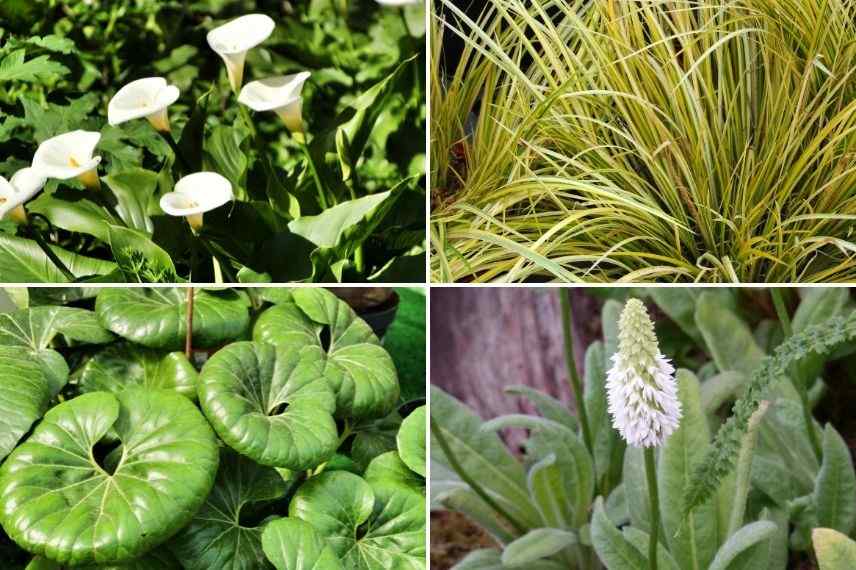
Zantedeschia aethiopica, Acorus gramineus ‘Ogon’, Farfugium japonicum and Primula vialii ‘Alison Holland’
In a natural wet garden
With its ribbon-like leaves reminiscent of grasses, particularly carex, acorus is perfect for creating a wild garden atmosphere. Thriving in cool to moist soil, acorus should be planted alongside perennials that require the same growing conditions. Acorus gramineus (or Japanese sweet flag) can easily blend into a naturalistic setting with its glossy green leaves forming a bristly, dense, and grassy tuft. The golden sedge, a riverside and marsh plant with long, slender yellow leaves edged in lime green, will bring a sense of freshness and lushness. A perennial for heavy soil with a very simple appearance, Persicaria ‘Pink Elephant’ adds colour to the garden with its candy-pink spike flowers from June to November. A bulbous plant for cool to moist soil and truly hardy, Camassia leichtlinii ‘Alba’ is perfectly suited to the situation. Its flower spikes bear white, wildflowers from May to June. In the background, the river thistle ‘Atropurpureum’ can reach up to 1.2 m tall, even in heavy soil, and reveals a magenta flowering. Don’t forget tall grasses for cool soil. Ethereal and ornamental, blue molinia ‘Skyracer’, for example, helps to structure the back of the garden with its culms reaching up to 2 m high.
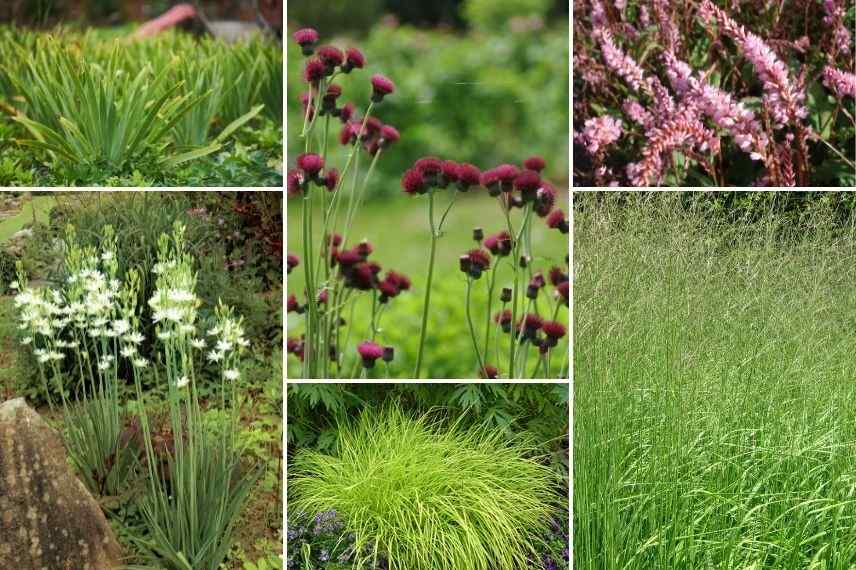
Acorus gramineus, Cirsium rivulare ‘Atropurpureum’ (photo Jean Jones), Persicaria amplexicaulis ‘Pink Elephant’, Camassia leichtlinii ‘Alba’, Carex elata ‘Aurea’ and Molinia caerulea ssp arundinacea ‘Skyracer’
Discover other Acorus
View all →Available in 2 sizes
Available in 1 sizes
Available in 2 sizes
Available in 1 sizes
Available in 1 sizes
Available in 1 sizes
Available in 1 sizes
In an aquatic scene
Acorus being a semi-aquatic plant, its planting by water bodies is a natural choice. TheAcorus calamus ‘Variegatus’ is effective for thickening a very wet area. Thanks to its rhizomatous stump, it easily develops in shallow water (from 0 to 20 cm of water) or in permanently moist soil. This perennial plant features bright bicoloured foliage, vivid green and cream white. Pair this fragrant bulrush with other plants for wet banks. Imagine a harmony of yellow and pink colours. The marsh spurge (Euphorbia palustris) with its yellow spring flowering thrives easily in full sun or partial shade, in heavy or marshy soils. Robust and fast-growing, it should preferably be placed where its growth won’t be a nuisance, as it can reach 1.5 m in height and 50 cm in width. Displaying pale pink umbel flowers in spring, from April to May, the Darmera peltata can be positioned by the pond. Note that it showcases beautiful autumn colours: its green leaves in summer turn orange, yellow, and rust in autumn. Astilbes are essential in very wet situations. They come in numerous varieties, offering a wide selection. I suggest theAstilbe crispa ‘Perkeo’, a small variety (25 cm in all directions) to green the banks in partial shade or sunny, but not scorching, conditions. It produces fine pink panicles in summer. Also consider the marsh iris producing beautiful yellow flowers or a Japanese iris (Iris ensata ‘Rose Queen’ for example) also suitable for wet areas. Acorus calamus ‘Variegatus’ being an aromatic plant used in phytotherapy and whose foliage releases a mandarin scent when crushed, you can pair it with water mint, which is also fragrant.
⇒ Discover our range of aquatic perennials

Acorus calamus ‘Variegatus’, Euphorbia palustris, Iris pseudacorus, Darmera peltata and Astilbe crispa ‘Perkeo’
In a mixed border
Acorus integrates well into perennial borders in cool soil. Pair its elegant silhouette with upright plants. The Lythrum salicaria ‘Robert’, for example, boasts a generous summer flowering with long carmine pink spikes. In a more violet hue, the Lobelia speciosa ‘Tania’ stands out from afar. For a white touch, consider the Japanese primrose ‘Alba’, which flowers generously from May to July. At the edge of the border, you can plant the dwarf aster Aster dumosus ‘Marjorie’, which enjoys cool soils. Compact, about 30 cm in all directions, it blooms from August to October in a lavender colour. Don’t hesitate to include perennials with colourful foliage, such as heucheras. Combine the Heuchera ‘Pinot Gris’ in coppery orange with the Heuchera ‘Mint Julep’ in a refreshing mint green. Both are delicately maculate with silver, and their veins are well defined. This is what makes these hardy perennials thrive in cool soils and withstand moisture.

Lobelia speciosa ‘Tania’, Primula japonica ‘Alba’, Lythrum salicaria ‘Robert’, Aster dumosus ‘Marjorie’, Acorus ogon, and Heuchera ‘Pinot Gris’
With decorative foliage plants
Variegated cultivars of acorus are very decorative. Take advantage of this and play with the colours and shapes of perennial foliage. For example, use Acorus gramineus ‘Variegata’ in combination with marsh bulrush with its upright stems, which closely resemble horsetail that also loves wetter soils. In a semi-shaded position, Athyrium filix-femina with its graceful, finely cut fronds can also accompany them. Japanese ferns are generally comfortable in wet areas, such as theAthyrium niponicum ‘Burgundy Lace’, which is very original with its silver foliage. An excellent groundcover for wet conditions, theAsarum epigynum ‘Takasago Saishin’ features heart-shaped (cordiform) green foliage marbled with grey. Moderately hardy, Colocasia esculenta ‘Madeira’ can also accompany acorus. This recent variety of elephant ear raises its dark greenish-black foliage up to 90 cm tall. In darker shades, Persicaria microcephala ‘Red Dragon’ surprises us with its triangular and deciduous leaves, bronze-green marked with purple-brown at the base and two silver lines in a “V” shape.
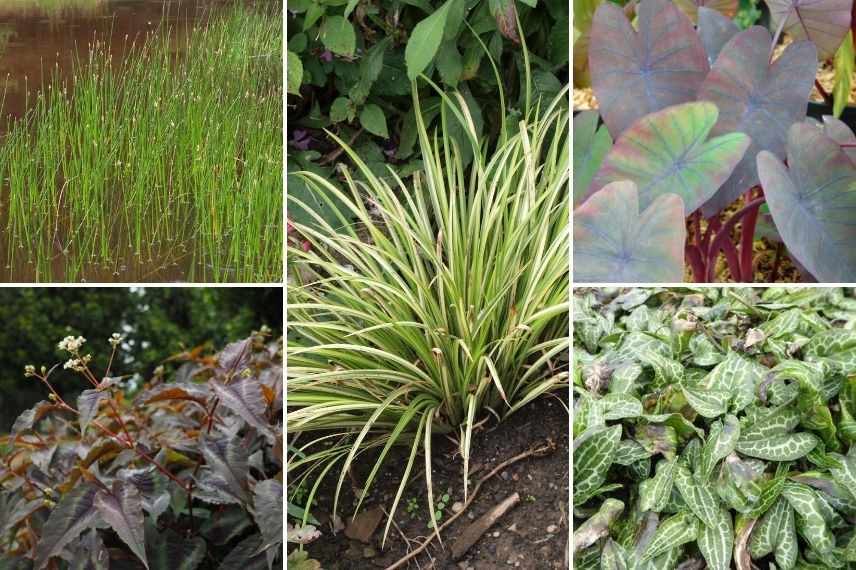
Eleocharis palustris (photo Wikipedia), Acorus gramineus ‘Variegata’ (photo FD Richards), Colocasia esculenta ‘Madeira’, Persicaria microcephala ‘Red Dragon’ and Asarum epigynum ‘Takasago Saishin’ (photo Guido)
In pot
Acorus can also be grown in pots. The Japanese rush and its varieties ‘Ogon’ and ‘Variegata’ are low plants that do not exceed 40 cm in height. They can therefore be easily integrated into pots, hanging baskets, or flowering planters. Larger, the variegated calamus (Acorus calamus ‘Variegatus’) is better suited for larger containers to allow its rhizomes to develop: large troughs, zinc basins, or sinks. The advantage of Acorus is its ability to be decorative almost all year round. In mild climates, this semi-evergreen perennial retains its foliage in winter. Acorus allows for creating displays with other plants throughout the seasons. For annuals and biennials, choose from petunia, nasturtium, canna, annual begonia, and digiplexis. Perennials that tolerate wet soils can be placed alongside Acorus in pots: hosta, Japanese grass, bergenia, moneywort, hellebore, creeping wintergreen, or even Cyperus papyrus, which can also be grown in a large pot on a terrace. Pair it with bulbous plants that thrive in moisture: daffodil, fritillary, camassia, summer snowflake, meadow squill.
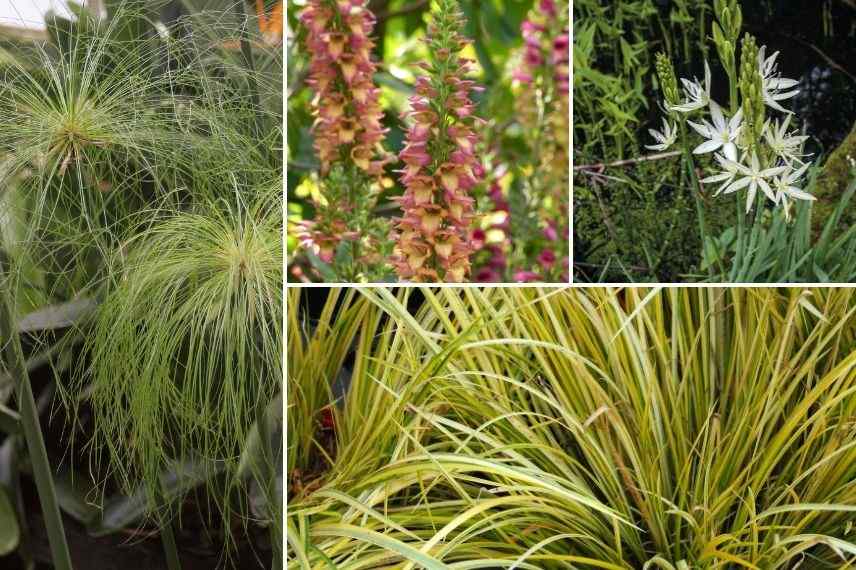
Cyperus papyrus (photo DavePape), Digiplexis ‘Illumination Flame’, Camassia leichtini ‘Alba’ and Acorus gramineus ‘Ogon’
- Subscribe!
- Contents
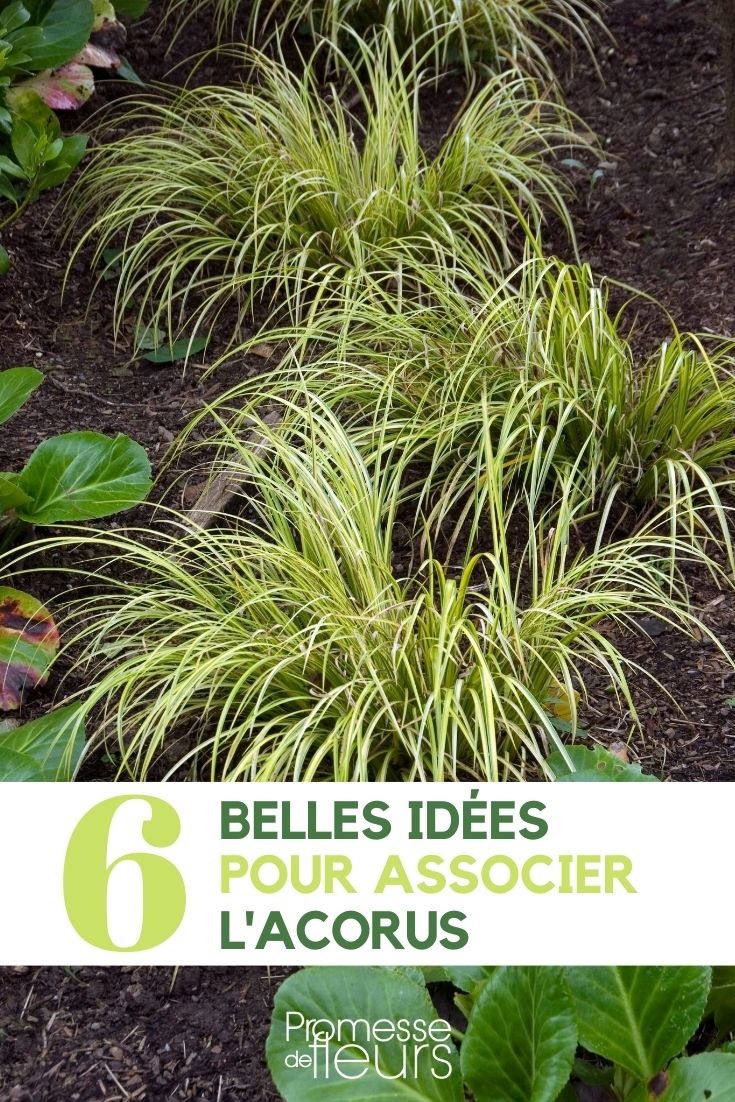































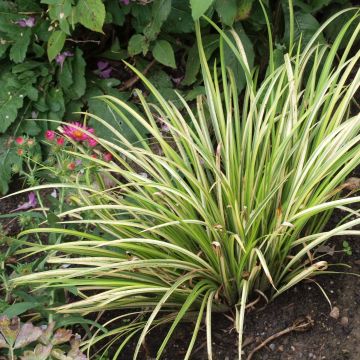
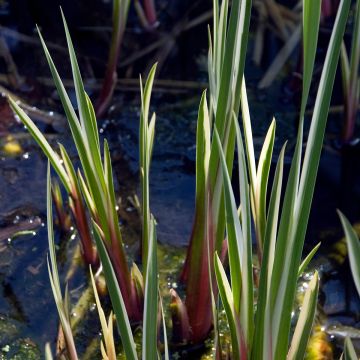
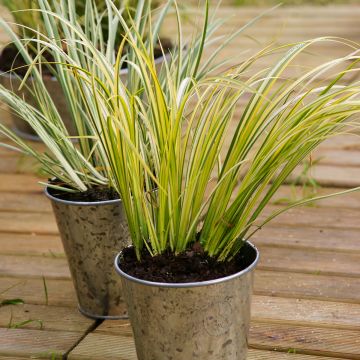
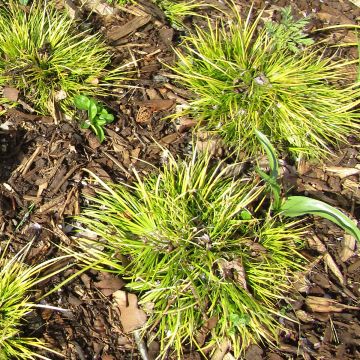
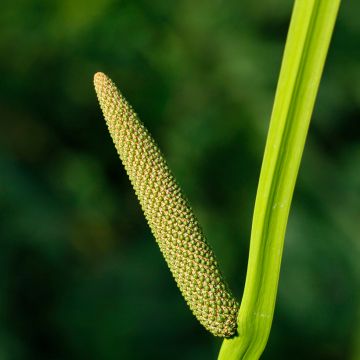

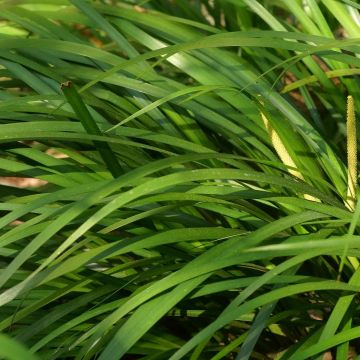
Comments